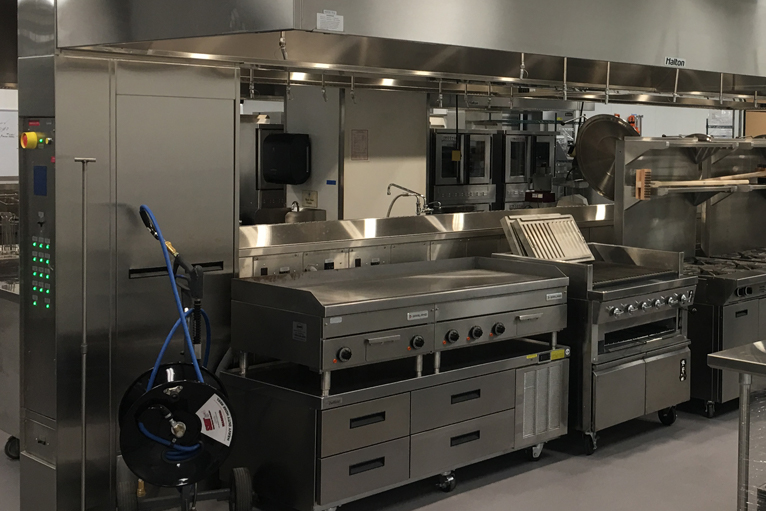Utility Distribution Systems (UDS) or also known as kitchen distribution systems are custom-built enclosures that can include any combination of gas, electrical, water, compressed air, steam, fire, and safety controls in a stainless steel structure. Utility distribution systems can be configured to be installed against a wall or for use with an island suite of appliances. The primary purpose of these systems is to provide all of the general utility requirements for the appliances positioned under the exhaust canopy. These utilities can also include wash sinks, fire systems, and exhaust and makeup air controls.
Typical Utility Distribution Systems configuration consists of two risers, one on each end of the exhaust canopy. Contained in the risers are the main terminal connections for the utilities. It is this single point of connection that makes the UDS desirable for institutional projects. The cost-benefit of a typical UDS is related to having the utilities for the appliances delivered from a single point of connection. The power supply, electricity, gas, water, etc., are distributed along the horizontal “raceway.” This raceway conceals and houses a variety of utilities, including:
Electrical distribution
- Electrical distribution can either be busbar or wire way. A busbar is a solid copper bar mounted on insulated blocks. The insulation blocks keep the bars separate and out of contact with other metal components. When using a 3 phase busbar, there is a bar for each phase. Busbars are more popular because they allow changing of the appliance receptacles more readily.
- Wireways are a direct connection from the breaker panel for each appliance receptacle.
- The sizing of the main panel and breaker is predetermined by the factory based on the appliances served. Typically a reserve is built into the overall load capacity for future additions or loads.
Plumbing distribution
- The plumbing in utility distribution systems can be gas, hot and cold water, steam supply and return, and compressed air.
- Water supply, hot and cold, is done in a manifold connection with the appropriately sized ball valves.
- Gas Supply size is based on the BTU load and pressure. The manufacturer will guide the selection of the appropriate pipe size and ensure all gas codes are met. A looped service is when the load exceeds a certain amount within a certain distance and ensures that all appliances, regardless of their location on the line, have sufficient gas volume.
- Other plumbing distribution could include steam supply, condensate return, and air.
Standard Features of typical Utility Distribution Systems include:
- Access doors allow access to the main risers and the connections along the raceway.
- Pedestals, when the horizontal raceway exceeds a certain length, these pedestals are incorporated to support the structure at the midpoint.
- Electrical plates are used to mount the appliance point-of-use branch circuit breakers to the busbar system.
- Riser mounted touch screens for system status of the ventilation system.
- Various indicator lights for a fuel source, active equipment, and fire system
- Fan switch (if not automated through Demand Control Ventilation)
- Bumper guards to prevent damage to the stainless shell
Utility Distribution Systems have proven to be very adaptable when changing appliances or equipment layouts. A comparison can be made to estimate whether using a UDS system is more cost-effective than having the utilities provided and built onsite.
Our recommended next article would be: Specifying Commercial Kitchen Exhaust Hoods
Leave us a comment below, and we will answer, or if you have any questions, please send us a message here
Subscribe today to kitchenventilation.com
Stay up to date by subscribing to Halton’s Commercial Kitchen Ventilation Blogs by entering your email address to subscribe and Halton will provide you with the latest information on commercial kitchen exhaust hoods, pollution control units, air handling, and safety systems. You will receive notifications of new posts by email.


